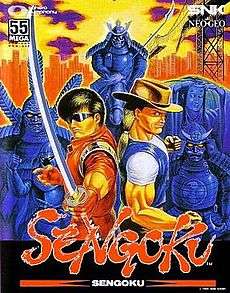Sengoku (1991 video game)
| Sengoku | |
|---|---|
 Neo Geo AES art cover | |
| Developer(s) | SNK |
| Publisher(s) | SNK |
| Platform(s) | Arcade, Neo Geo, Neo Geo CD, PlayStation 2, Mega-CD, Super Famicom |
| Release | |
| Genre(s) | Fighting, Beat 'em up |
| Mode(s) | Single-player, multiplayer |
| Cabinet | Upright |
| Display | Horizontal, raster (standard resolution) |
Sengoku, fully titled Sengoku Denshō (戦国伝承, lit. "Legacy of the Warring States") in Japan, is a beat 'em up arcade game. It is the first game of the Sengoku series by SNK. It was ported to numerous home consoles including the Neo Geo, Neo Geo CD, Mega-CD and Super Famicom. The arcade version was part of SNK Arcade Classics Vol. 1, released in 2008. The Neo Geo version was re-released on the Japanese Virtual Console in 2011, with the sequels for the North American Virtual Console on November 8, 2012 (Sengoku 2) and June 6, 2013 (Sengoku 3) and for the PAL region on February 7, 2013 (Sengoku 2) and September 5, 2013 (Sengoku 3). In 2009 the series was compiled on a CD titled Sengoku Anthology for PlayStation 2 and Windows.
Plot
Centuries ago a cruel and insanely tyrannical warlord was defeated by the two elite Samurais but had sworn to return in the future. When he does he unleashes undead forces of feudal Japanese warriors to destroy the world and its people. The warlord is opposed only by the two protagonists, a ninja and a Western cowboy (named Ninja Dave and Cowboy Kev in the Neo-Geo version[1] and named Dan and Bill in the SNES version), who turn out to be descendants of the two elite Samurais responsible for vanquishing the wicked warlord centuries ago.
Gameplay
A player has a maximum of six health points. When certain enemies are defeated, spirits of powerful forms are available to transform into. In the SNES version transformation cannot be toggled, but stays constant for a limited time. The three different forms are a samurai warrior, an armour-clad wolf and a more agile ninja. These forms have a limited use. Their attacks and jumps differ from the original form and their powers are enhanced by any powerups collected.
Throughout the game the player will need to survive the hordes of enemies by collecting coloured orbs as powerups. Five Green orbs heal one health point. A Red orb gives the player a single sword, a Cyan orb gives the player double sword, the Purple orb gives the player a two-handed holy sword and a Yellow orb gives the player a limited magical attack.
Reception
| Sengoku | ||||||||
|---|---|---|---|---|---|---|---|---|
| ||||||||
On release, Famicom Tsūshin scored the Neo Geo version of the game a 19 out of 40.[3] Electronic Gaming Monthly gave the Super NES version a 4.4 out of 10, commenting that it "has an interesting concept as you can change into different types of fighters, yet it just doesn't come together."[2]
References
- 1 2 "Computer & Video Games, January '92" (122). Computer & Video Games. January 1992: 38. Retrieved 21 July 2017.
- 1 2 "Review Crew: Sengoku". Electronic Gaming Monthly. No. 56. Sendai Publishing. March 1994. p. 34.
- ↑ NEO GEO GAMES CROSS REVIEW: 戦国伝承. Weekly Famicom Tsūshin. No.332. Pg.25. 28 April 1995.